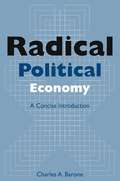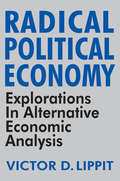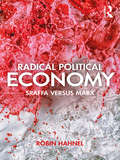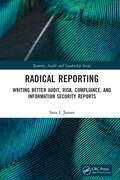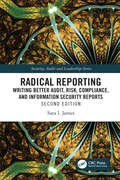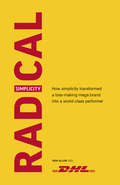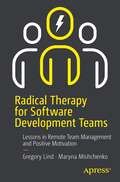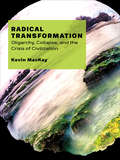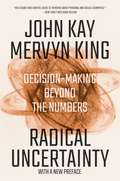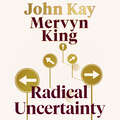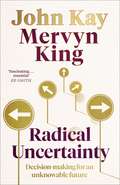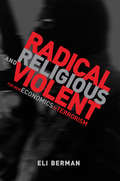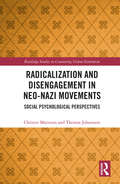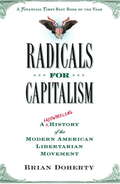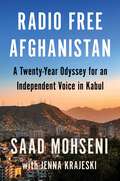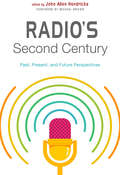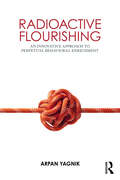- Table View
- List View
Radical Political Economy: A Concise Introduction
by Charles A. BaroneThis straightforward introduction to radical political economy strikes a balance between breadth and depth and was written for the beginning student and others interested in a relatively short text on radical economics.
Radical Political Economy: Explorations in Alternative Economic Analysis
by Victor LippitRadical political economy is built upon the formal analysis of neoclassical economics and the tradition of Marxian/radical analysis. The essays presented in this book offer a representative sampling of the issues and methodologies involved in the study of radical political economy.
Radical Political Economy: Sraffa Versus Marx
by Robin HahnelFor too long radical political economy has suffered for lack of a coherent alternative to formal Marxian economic theory. People have had to choose between (1) continuing to use a formal model based on the labor theory of value as Marx developed in Capital to justify and retain one’s opposition to capitalism, or (2) abandoning the formal Marxian framework as outdated, and risk losing a critical evaluation of capitalism. Radical Political Economy: Sraffa Versus Marx provides readers with a third choice. A point-by-point comparison of Sraffian and Marxian treatments of prices, profits, technological change, economic crises, environmental sustainability, and the moral case against capitalism, are presented in six core chapters. They explain how the Sraffian treatment surpasses the formal Marxian treatment in every case. Both Marxian and Sraffian theories are presented in a highly accessible way, while large professional literatures are thoroughly referenced throughout. Marx was not the first, but remains the greatest, critic of capitalism, and richly deserves his place in history. However it is time to use intellectual tools unavailable to Marx in the nineteenth century to improve upon his formal analysis. This book is of great importance to those who study Sraffa and Marx, as well as academics and students who are interested in political economy, the history of economic thought, and economic and philosophical theory.
Radical Product Thinking: The New Mindset for Innovating Smarter
by R. DuttIteration rules product development, but it isn't enough to produce dramatic results. This book champions Radical Product Thinking, a systematic methodology for building visionary, game-changing products.Methodologies such as Lean and Agile have democratized innovation by teaching us to harness the power of iteration to innovate faster, but our ability to set a clear destination hasn't kept up with the pace. When we iterate without a clear vision or strategy, our products become bloated, fragmented, and driven by irrelevant metrics. They catch "product diseases" that are often fatal to true innovation. In Radical Product Thinking (RPT), product development is led by the vision for the change it's intended to create. This methodology helps leaders reimagine the problems they face and align their team to find creative solutions using five elements: Vision, Strategy, Prioritization, Execution, and Culture. R. Dutt guides readers through these elements so they develop a clear process for achieving their desired change, incorporate it into daily activities, and turn RPT skills into muscle memory. This book gives organizations a repeatable model for building vision-driven products by helping us systematically translate vision and strategy into everyday actions so our product becomes a vehicle for creating the change we want to see in the world. Dutt shows us that you don't have to be a natural-born visionary to produce extraordinary results.
Radical Pushes: Placing Design-Driven Innovation in the Strategy of a Firm
by Roberto VergantiMost analysts hold that the innovation strategy of firms consists of two domains: incremental and radical. According to these theories, radical innovation is the realm of technological breakthroughs. The meanings behind products are supposed to be part of the first domain: companies can understand them better only by scrutinizing user behavior and using the resulting insights to improve their products. In this chapter, however, noted innovation expert Roberto Verganti shows that innovation of meanings, like innovation of technologies, may also be radical. And radical innovation of meanings is rarely pulled by users but is instead proposed by firms. Thus, there is a third--and largely unexplored--domain in the innovation strategy of firms: design-driven innovation. This chapter was originally published as chapter 3 of "Design-Driven Innovation: Changing the Rules of Competition by Radically Innovating What Things Mean."
Radical Reporting: Writing Better Audit, Risk, Compliance, and Information Security Reports (Security, Audit and Leadership Series)
by Sara I. JamesMost people dread writing reports; they also dread reading reports. What they don’t realize is that the techniques that make writing more readable make it more powerful. This is especially relevant for professionals in areas such as audit, risk, compliance, and information security. This small volume provides the tools and techniques needed to improve reports. It does so through addressing crucial concepts all too often overlooked in the familiar rush to perform tasks, complete projects, and meet deadlines. These concepts – the role of culture in communication; the link between logic and language; the importance of organizing thoughts before writing; and how to achieve clarity – may seem academic or theoretical. They’re not. Unless writers understand their own thoughts, actions, and objectives, they cannot hope to communicate them at all – let alone clearly.
Radical Reporting: Writing Better Audit, Risk, Compliance, and Information Security Reports (Security, Audit and Leadership Series)
by Sara I. James"If I were giving out an award for 'book of the year' for internal audit professionals, I would certainly award it to her outstanding manuscript: Radical Reporting: Writing Better Audit, Risk, Compliance and Information Security Reports." - Richard Chambers, Former President and CEO, The Institute of Internal AuditorsMost people dread writing reports; they also dread reading reports. What they don’t realize is that the techniques that make writing more readable make it more powerful. This is especially relevant for professionals in areas such as audit, risk, compliance, and information security.This small volume provides the tools and techniques needed to improve reports. It does so through addressing crucial concepts all too often overlooked in the familiar rush to perform tasks, complete projects, and meet deadlines.These concepts – the role of culture in communication; the link between logic and language; the importance of organizing thoughts before writing; and how to achieve clarity – may seem academic or theoretical. They’re not. Unless writers understand their own thoughts, actions, and objectives, they cannot hope to communicate them at all – let alone clearly.This second edition develops these points with additional material on critical thinking, as well as the use of AI in reporting.
Radical Simplicity: How simplicity transformed a loss-making mega brand into a world-class performer
by Ken AllenThe key to rising to the top of your company lies in a simple message and philosophy. The ultimate inspirational story for ambitious innovators, market-disruptors, and global business entrepreneurs. Celebrating DHL’s fiftieth anniversary as a world-leading delivery company, global CEO Ken Allen tells the unique story of his journey to the top of the industry. In this business memoir, he shares the strategies and skills he has developed throughout his career, drawing on both his core values and extensive experience. This book is an inimitable guide to succeeding in any business, focusing on strategy and practical advice while revealing the simple lessons you need to learn to excel in life and work. It is an accessible read for entrepreneurs and managers at any stage of their career, packed with motivational material and no-nonsense tips. This simple and honest book is a must-have for anyone looking to reach the top of their field.
Radical Therapy for Software Development Teams: Lessons in Remote Team Management and Positive Motivation
by Gregory Lind Maryna MishchenkoBuild and maintain effective, collaborative, and motivated software development teams. This book addresses the challenges in doing so, like communication gaps, trust issues, and motivation problems, and provides strategies to overcome them. You'll be introduced to the Radical Therapy Dev philosophy, a holistic approach designed to optimize software development teams for better performance and overall well-being. This book highlights common pain points in software development and offers solutions to resolving much of the issues in teams. It offers strategies for implementation, focusing on adaptability and accountability, while also promoting community-supported standards. And, the book reveals why an emphasis on fostering a growth mindset, mentorship programs, and junior-intern initiatives promotes continuous learning and collaboration.With the rise of remote work, you'll see why hiring globally while thinking locally is gaining popularity. You'll also gain insights into removing barriers to remote work, along with tools and policies for remote collaboration. Additionally, the book explores the concept of cloud-native software development and its benefits. Radical Therapy for Software Development Teams critiques the traditional "agile" methodology, identifying its shortcomings while extracting valuable lessons that can still be applied effectively. What You Will LearnAddress communication gaps, foster trust, and nurture a growth mindset among team membersAvoid common feedback mistakes, recognize accomplishments, and implement a reward systemImprove software development practices and team dynamics Take a scientific approach to project management rather than traditional requirements gatheringBreak Down Communication BarriersWho This Book is ForSoftware development professionals
Radical Transformation: Oligarchy, Collapse, and the Crisis of Civilization
by Kevin MacKayRadical Transformation is a story about industrial civilization’s impending collapse, and about the possibilities of averting this fate. Human communities first emerged as egalitarian, democratic groups that existed in symbiotic relationship with their environments. Increasing complexity led to the emergence of oligarchy, in which societies became captive to the logic of domination, exploitation, and ecological destruction. The challenge facing us today is to build a movement that will radically transform civilization and once more align our evolutionary trajectory in the direction of democracy, equality, and ecological sustainability.
Radical Uncertainty: Decision-making Beyond The Numbers
by John Kay Mervyn KingMuch economic advice is bogus quantification, warn two leading experts in this essential book. Invented numbers offer false security; we need instead robust narratives that yield the confidence to manage uncertainty. Some uncertainties are resolvable. The insurance industry’s actuarial tables and the gambler’s roulette wheel both yield to the tools of probability theory. Most situations in life, however, involve a deeper kind of uncertainty, a radical uncertainty for which historical data provide no useful guidance to future outcomes. Radical uncertainty concerns events whose determinants are insufficiently understood for probabilities to be known or forecasting possible. Before President Barack Obama made the fateful decision to send in the Navy Seals, his advisers offered him wildly divergent estimates of the odds that Osama bin Laden would be in the Abbottabad compound. In 2000, no one—not least Steve Jobs—knew what a smartphone was; how could anyone have predicted how many would be sold in 2020? And financial advisers who confidently provide the information required in the standard retirement planning package—what will interest rates, the cost of living, and your state of health be in 2050?—demonstrate only that their advice is worthless. The limits of certainty demonstrate the power of human judgment over artificial intelligence. In most critical decisions there can be no forecasts or probability distributions on which we might sensibly rely. Instead of inventing numbers to fill the gaps in our knowledge, we should adopt business, political, and personal strategies that will be robust to alternative futures and resilient to unpredictable events. Within the security of such a robust and resilient reference narrative, uncertainty can be embraced, because it is the source of creativity, excitement, and profit.
Radical Uncertainty: Decision-making for an unknowable future
by John Kay Mervyn KingLONGLISTED FOR THE FT/MCKINSEY BUSINESS BOOK OF THE YEAR AWARD 2020'A brilliant new book' Daily Telegraph'Well written . . . and often entertaining'The Times'A sparkling analysis'Prospect'Entertaining and enlightening . . . This is a necessary critique and they make it with verve, knowledge and a wealth of stories' Financial Times'An elegant, wise and timely book' Irish Times'Jam-packed with erudition' New StatesmanThis major, critically acclaimed work asks a vitally important question for today: when uncertainty is all around us, and the facts are not clear, how can we make good decisions? We do not know what the future will hold, particularly in the midst of a crisis, but we must make decisions anyway. We regularly crave certainties which cannot exist and invent knowledge we cannot have, forgetting that humans are successful because we have adapted to an environment that we understand only imperfectly. Throughout history we have developed a variety of ways of coping with the radical uncertainty that defines our lives. This incisive and eye-opening book draws on biography, history, mathematics, economics and philosophy to highlight the most successful - and most short-sighted - methods of dealing with an unknowable future. Ultimately, the authors argue, the prevalent method of our age falls short, giving us a false understanding of our power to make predictions, leading to many of the problems we experience today.
Radical Uncertainty: Decision-making for an unknowable future
by John Kay Mervyn KingLONGLISTED FOR THE FT/MCKINSEY BUSINESS BOOK OF THE YEAR AWARD 2020'A brilliant new book' Daily Telegraph'Well written . . . and often entertaining'The Times'A sparkling analysis'Prospect'Entertaining and enlightening . . . This is a necessary critique and they make it with verve, knowledge and a wealth of stories' Financial Times'An elegant, wise and timely book' Irish Times'Jam-packed with erudition' New StatesmanThis major, critically acclaimed work asks a vitally important question for today: when uncertainty is all around us, and the facts are not clear, how can we make good decisions? We do not know what the future will hold, particularly in the midst of a crisis, but we must make decisions anyway. We regularly crave certainties which cannot exist and invent knowledge we cannot have, forgetting that humans are successful because we have adapted to an environment that we understand only imperfectly. Throughout history we have developed a variety of ways of coping with the radical uncertainty that defines our lives. This incisive and eye-opening book draws on biography, history, mathematics, economics and philosophy to highlight the most successful - and most short-sighted - methods of dealing with an unknowable future. Ultimately, the authors argue, the prevalent method of our age falls short, giving us a false understanding of our power to make predictions, leading to many of the problems we experience today.
Radical, Religious, and Violent: The New Economics of Terrorism
by Eli BermanApplying fresh tools from economics to explain puzzling behaviors of religious radicals: Muslim, Christian, and Jewish; violent and benign. How do radical religious sects run such deadly terrorist organizations? Hezbollah, Hamas, Lashkar-e-Taiba, and the Taliban all began as religious groups dedicated to piety and charity. Yet once they turned to violence, they became horribly potent, executing campaigns of terrorism deadlier than those of their secular rivals. In Radical, Religious, and Violent, Eli Berman approaches the question using the economics of organizations. He first dispels some myths: radical religious terrorists are not generally motivated by the promise of rewards in the afterlife (including the infamous seventy-two virgins) or even by religious ideas in general. He argues that these terrorists (even suicide terrorists) are best understood as rational altruists seeking to help their own communities. Yet despite the vast pool of potential recruits—young altruists who feel their communities are repressed or endangered—there are less than a dozen highly lethal terrorist organizations in the world capable of sustained and coordinated violence that threatens governments and makes hundreds of millions of civilians hesitate before boarding an airplane. What's special about these organizations, and why are most of their followers religious radicals? Drawing on parallel research on radical religious Jews, Christians, and Muslims, Berman shows that the most lethal terrorist groups have a common characteristic: their leaders have found a way to control defection. Hezbollah, Hamas, and the Taliban, for example, built loyalty and cohesion by means of mutual aid, weeding out “free riders” and producing a cadre of members they could rely on. The secret of their deadly effectiveness lies in their resilience and cohesion when incentives to defect are strong. These insights suggest that provision of basic social services by competent governments adds a critical, nonviolent component to counterterrorism strategies. It undermines the violent potential of radical religious organizations without disturbing free religious practice, being drawn into theological debates with Jihadists, or endangering civilians.
Radicalization and Disengagement in Neo-Nazi Movements: Social Psychology Perspective (Routledge Studies in Countering Violent Extremism)
by Thomas Johansson Christer MattssonThis book offers an in-depth study of personal accounts of men and women who have at one time entered, participated in and ultimately exited the neo-Nazi movement, with a focus on advanced Western states. Through detailed stories of the movement’s violence, hatred, and ideology, coupled with narratives of the individuals’ life plans and dreams when entering the movement and reintegrating into society, the work provides knowledge, hope and new directions for readers to better understand and react to a reinvigorated extreme right across Western nations. The book provides innovative research on the relationship between the life trajectories of neo-Nazis and their significant others, enabling better and more evidence-based strategies for preventing radicalization and promoting deradicalization. The extensive case studies include the voices of those who returned to the movement, or never left at all, providing a rare opportunity to compare active, former and returned right-wing extremists. The main contribution of the book is to provide an innovative approach to the oral history of young men and women who have participated in different national and local neo-Nazi movements in Western countries, namely Sweden and the United States. In order to understand the current trends within the movement and their relationship to the surrounding society, this shift calls for in-depth analyses based on social-psychological and sociological perspectives. Stressing the importance of having a gender theory, socio-cultural, historical, and both a national and contextual perspective on the neo-Nazi movement, this book contributes new knowledge to this field of research. This book will be of much interest to students of political extremism, radicalisation, terrorism studies and social psychology.
Radicals for Capitalism: A Freewheeling History of the Modern American Libertarian Movement
by Brian DohertyOn Wall Street, in the culture of high tech, in American government: Libertarianism-the simple but radical idea that the only purpose of government is to protect its citizens and their property against direct violence and threat- has become an extremely influential strain of thought. But while many books talk about libertarian ideas, none until now has explored the history of this uniquely American movement-where and who it came from, how it evolved, and what impact it has had on our country. In this revelatory book, based on original research and interviews with more than 100 key sources, Brian Doherty traces the evolution of the movement through the unconventional life stories of its most influential leaders- Ludwig von Mises, F. A. Hayek, Ayn Rand, Murray Rothbard, and Milton Friedman-and through the personal battles, character flaws, love affairs, and historical events that altered its course. And by doing so, he provides a fascinating new perspective on American history-from the New Deal through the culture wars of the 1960s to today's most divisive political issues. Neither an exposé nor a political polemic, this entertaining historical narrative will enlighten anyone interested in American politics.
Radio Free Afghanistan: A Twenty-Year Odyssey for an Independent Voice in Kabul
by Jenna Krajeski Saad MohseniFrom Time 100 honoree Saad Mohseni, the deeply moving and surprising story of the attempt to build a truly independent media company in contemporary Afghanistan. Saad Mohseni, chairman and CEO of Moby Group, Afghanistan’s largest media company, charts a twenty-year effort to bring a free press to his country after years of Taliban rule, and how that effort persists even after the Taliban’s return to power in 2021.In the heady early days of the American occupation, Mohseni returns to Kabul which he had last seen as a child before the Soviet invasion. Casting about for ways to be involved in the dawn of a new Afghanistan, Mohseni makes what seems like a quixotic decision to leave the comforts of a career in international banking to start a Kabul radio station with his three siblings. This unlikely venture quickly blossoms into a burgeoning television empire, bringing Mohseni and his family and employees into sometimes uncomfortable contact with everyone who has a stake in the country—from the government of Hamid Karzai to White House officials. Moreover, their radio and television networks soon become a necessary beacon for millions of Afghans, who rely on them not just for independent news but for joyful pleasures like soap operas and Afghan Star, a beloved national singing competition in a country whose previous rulers had banned (and would again ban) music. Mohseni’s position at Moby affords him unique insights into this extraordinary yet troubled country, the youngest in the world outside of Sub-Saharan Africa, and his powerful account captures the spirit and resilience of the Afghan people—notably the hundreds of men and women still working in Moby's Kabul office today, who, once again under Taliban rule, create programs, report the news, and educate the public.Radio Free Afghanistan is a stunning, vibrant portrait of a nation in turmoil, poised between despair and hope.
Radio One, Inc.
by Richard S. Ruback Pauline FischerRadio One (NYSE: ROIA and RIOAK), the largest radio group targeting African-Americans in the country, had the opportunity to acquire 12 urban stations in the top 50 markets from Clear Channel Communications, Inc. (NYSE: CCU) in the winter of 2000. The stations were being sold by Clear Channel Communications, Inc. to obtain Federal Communications Commission (FCC) approval for its acquisition of AMFM, Inc. (NYSE: AFM). Radio One was also negotiating the acquisition of nine stations in Charlotte, North Carolina, Augusta, Georgia, and Indianapolis, Indiana. The proposed acquisitions would double the size of Radio One. The case focuses on the strategic and financial evaluation of the proposed acquisitions.
Radio's Second Century: Past, Present, and Future Perspectives
by Bruce Mims John Allen Hendricks Daniel Riffe Brad Clark Mark Ward Lu Wu Laith Zuraikat Joseph R. Blaney David Crider Rachel Sussman-Wander Kaplan John F. Barber Emily W. Easton John Mark Dempsey Anjuli Joshi Brekke Anne F. MacLennan Archie McLean Michael Nevradakis Simon OrderOne of the first books to examine the status of broadcasting on its one hundredth anniversary, Radio’s Second Century investigates both vanguard and perennial topics relevant to radio’s past, present, and future. As the radio industry enters its second century of existence, it continues to be a dominant mass medium with almost total listenership saturation despite rapid technological advancements that provide alternatives for consumers. Lasting influences such as on-air personalities, audience behavior, fan relationships, and localism are analyzed as well as contemporary issues including social and digital media. Other essays examine the regulatory concerns that continue to exist for public radio, commercial radio, and community radio, and discuss the hindrances and challenges posed by government regulation with an emphasis on both American and international perspectives. Radio’s impact on cultural hegemony through creative programming content in the areas of religion, ethnic inclusivity, and gender parity is also explored. Taken together, this volume compromises a meaningful insight into the broadcast industry’s continuing power to inform and entertain listeners around the world via its oldest mass medium--radio.
Radioactive Flourishing: An Innovative Approach to Perpetual Behavioral Enrichment
by Arpan YagnikRadioactive Flourishing is for seekers of lasting happiness and peace. Radioactive Flourishing supplies cognitive insights for eventual behavioral stability. The USP of the book is its flipped human response toward instability. This book’s primary goal is to help people learn ways to flourish individually despite being surrounded by instability.This book is intentionally written in the "katha" style, which means that there are numerous relatable stories and a consistent journey from the core to the periphery, then to the tangent, and back. The implicit and explicit repetition of the key manifest enables the core intervening stimulation to encourage its readers to dig deeper and find solid footing in their flourishing being. This book is for seekers of happiness and peace.This book will be useful to students, researchers, young professionals, and faculty members working in the fields of business administration, psychology, start-ups, finance, entrepreneurship, and communication. It will also be an invaluable resource for aspiring leaders and students of life.
Radiobiology and Environmental Security
by Carmel E Mothersill Colin B. Seymour Victoria KorogodinaThis volume - like the NATO Advanced Research Workshop on which it is based - addresses the fundamental science that contributes to our understanding of the potential risks from ecological terrorism, i.e. dirty bombs, atomic explosions, intentional release of radionuclides into water or air. Both effects on human health (DNA and systemic effects) and on ecosystems are detailed, with particular focus on environmentally relevant low-dose ranges. The state-of-the-art contributions to the book are authored by leading experts; they tackle the relevant questions from the perspectives of radiation genetics, radiobiology, radioecology, radiation epidemiology and risk assessment.
Radiohead: Music at Your Own Price (A)
by Anita Elberse Jason BergsmanIn October 2007, the British band Radiohead caused a stir when it announced it would allow customers to decide how much to pay for its new album, released exclusively as a digital download and available only from the band's own web site. The pricing plan represented a significant break from the industry standard of fixed prices for music, typically 99 cents for individual songs and upward of $9.99 for complete albums. How viable is such a "name-your-own-pricing" plan? And what does Radiohead's move say about the future of the music industry?
Radiohead: Music at Your Own Price (A)
by Anita Elberse Jason BergsmanIn October 2007, the British band Radiohead caused a stir when it announced it would allow customers to decide how much to pay for its new album, released exclusively as a digital download and available only from the band's own web site. The pricing plan represented a significant break from the industry standard of fixed prices for music, typically 99 cents for individual songs and upward of $9.99 for complete albums. How viable is such a "name-your-own-pricing" plan? And what does Radiohead's move say about the future of the music industry?
Radiohead: Music at Your Own Price (A)
by Anita Elberse Jason BergsmanIn October 2007, the British band Radiohead caused a stir when it announced it would allow customers to decide how much to pay for its new album, released exclusively as a digital download and available only from the band's own web site. The pricing plan represented a significant break from the industry standard of fixed prices for music, typically 99 cents for individual songs and upward of $9.99 for complete albums. How viable is such a "name-your-own-pricing" plan? And what does Radiohead's move say about the future of the music industry?
Radiohead: Music at Your Own Price (A)
by Anita Elberse Jason BergsmanIn October 2007, the British band Radiohead caused a stir when it announced it would allow customers to decide how much to pay for its new album, released exclusively as a digital download and available only from the band's own website. The pricing plan represented a significant break from the industry standard of fixed prices for music, typically 99 cents for individual songs and upward of $9.99 for complete albums. How viable is such a "name-your-own-pricing" plan? And what does Radiohead's move say about the future of the music industry?
